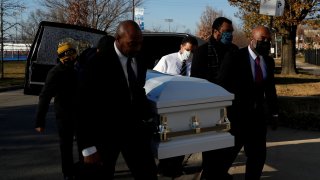
- December is on pace to surpass April as the deadliest month of Covid-19 in the United States.
- Slightly more than halfway into December, the month's death toll is already at 70% of April's count.
- If the country reports an average of more than 1,300 daily deaths for the rest of the month, December will surpass the April total.
December is on pace to become the deadliest month of the Covid-19 pandemic in the United States, surpassing April, when more than 60,738 Americans lost their lives to the coronavirus.
Hospitals across the U.S. are becoming overwhelmed and people are dying in record numbers once again — even as U.S. and state officials rush to get lifesaving vaccine doses across the nation. December is already the second-deadliest month of the pandemic in the U.S., with more than 42,500 Covid-19 deaths as of Thursday and with two weeks left in the month, according to data compiled by Johns Hopkins University.
At the early height of the pandemic in April, hospitals in the New York City region were overwhelmed by Covid patients, and doctors had little knowledge of how to treat them. The country also wasn't testing as many people for the virus in April, so the death toll for that month could be higher than original data shows, epidemiologists caution.
The U.S. is currently reporting more than 2,600 deaths per day, based on a weekly average, versus an average of roughly 2,025 fatalities a day in April.

The record is coming even as the U.S. begins to roll out a vaccine against the disease. But health officials and medical personnel are cautioning that a vaccine won't give the country immediate relief from the outbreak.
Money Report
Dr. Syra Madad, senior director of the systemwide special pathogens program at New York City Health + Hospitals, called the latest Covid surge "a terrible case of deja vu."
"It's a terrible PTSD, knowing that we were on the front lines and in the epicenter first, and now seeing the whole nation not learn from the lessons of the Northeast," she said in a phone interview. "You can't have magical thinking that the virus is going to go away on its own without having a containment and mitigation strategy."
She added that the outbreak is going to continue to get worse before it gets better, based on current trends.
"If you don't do anything, things will absolutely get worse," she said. "When you have cases running rampant we have to put restrictions in place, but I think we can be much more strategic because we've learned a lot about how the virus spreads."
People need to hold tight and limit their interactions with others while the country works to roll out the vaccine, Madad said.
"We do have an incredible scientific achievement that health-care workers across the country are benefiting from," Dr. Leana Wen, a former Baltimore health commissioner, said in a phone interview. "At the same time, we're also seeing unprecedented numbers of people getting ill, hospitalized and dying."
The country reported more than 233,200 new infections Thursday, according to Hopkins data, and more than 3,200 deaths. Many hospitals across the country are running out of available intensive-care units, standard beds, and staff to handle the surge in patients, data published by the Department of Health and Human Services shows.
Large states such as Texas, Illinois, Pennsylvania and California have each reported nearly 3,000 deaths or more this month, driving a significant portion of the national total. But many smaller states have been hit disproportionately hard by the virus, with North Dakota, South Dakota, Iowa, New Mexico and Kansas topping the list when adjusting for population.
Despite some signs of daily new cases slowing in the Midwest, new case counts are still increasing nationwide, hitting a fresh peak of nearly 217,000 average cases per day as of Thursday.
"Basically, what we're seeing now is the worst-case scenario of what we predicted several months ago. This is the deadly winter that we thought could be the case if people did not take the actions necessary to protect themselves and their loved ones," said Wen, an emergency physician and public health professor at George Washington University.
Some state and local officials are implementing new restrictions to curb the spread of the virus and protect hospitals from being overwhelmed. California Gov. Gavin Newsom has issued orders that trigger restrictions when regions of the state reach a certain level of intensive-care occupancy. Several regions have triggered new stay-at-home orders.
And New York City Mayor Bill de Blasio in recent days has called for more restrictions, saying that "all forms of restrictions have to be on the table." He has floated the idea of severe restriction after Christmas, while Gov. Andrew Cuomo has said restrictions could be coming to New York City in January, if current trends hold.
As officials weigh implementing new restrictions, the Centers for Disease Control and Prevention has called on Americans not to travel for Christmas and to limit all nonessential travel.
"I'm extremely concerned about Christmas," Wen said. "There is such a high level of virus across the country and I just hope that people will keep in mind the end is not far away. We just need to get through this holiday and through this winter."
— CNBC's Nate Rattner contributed to this report.






